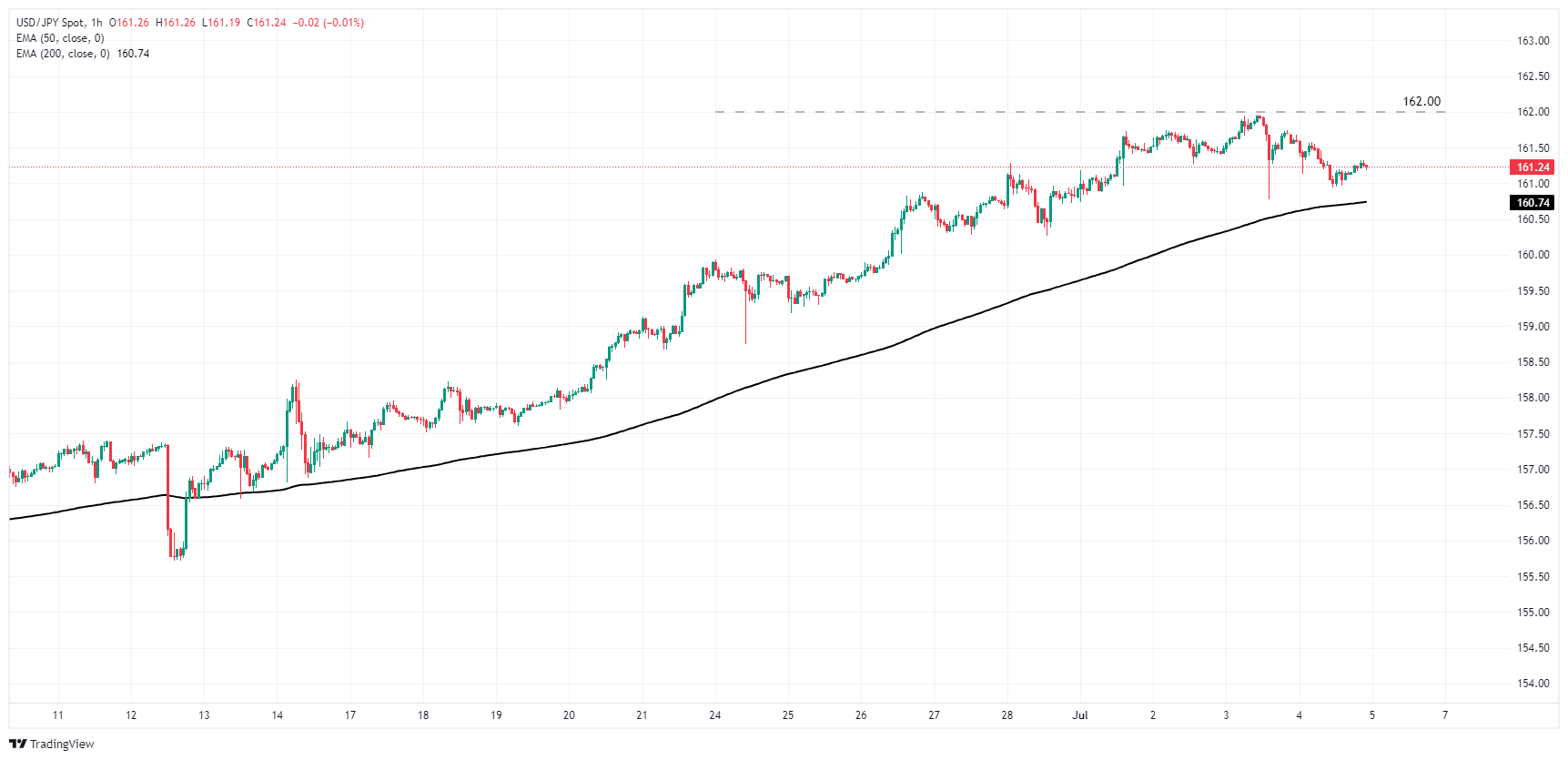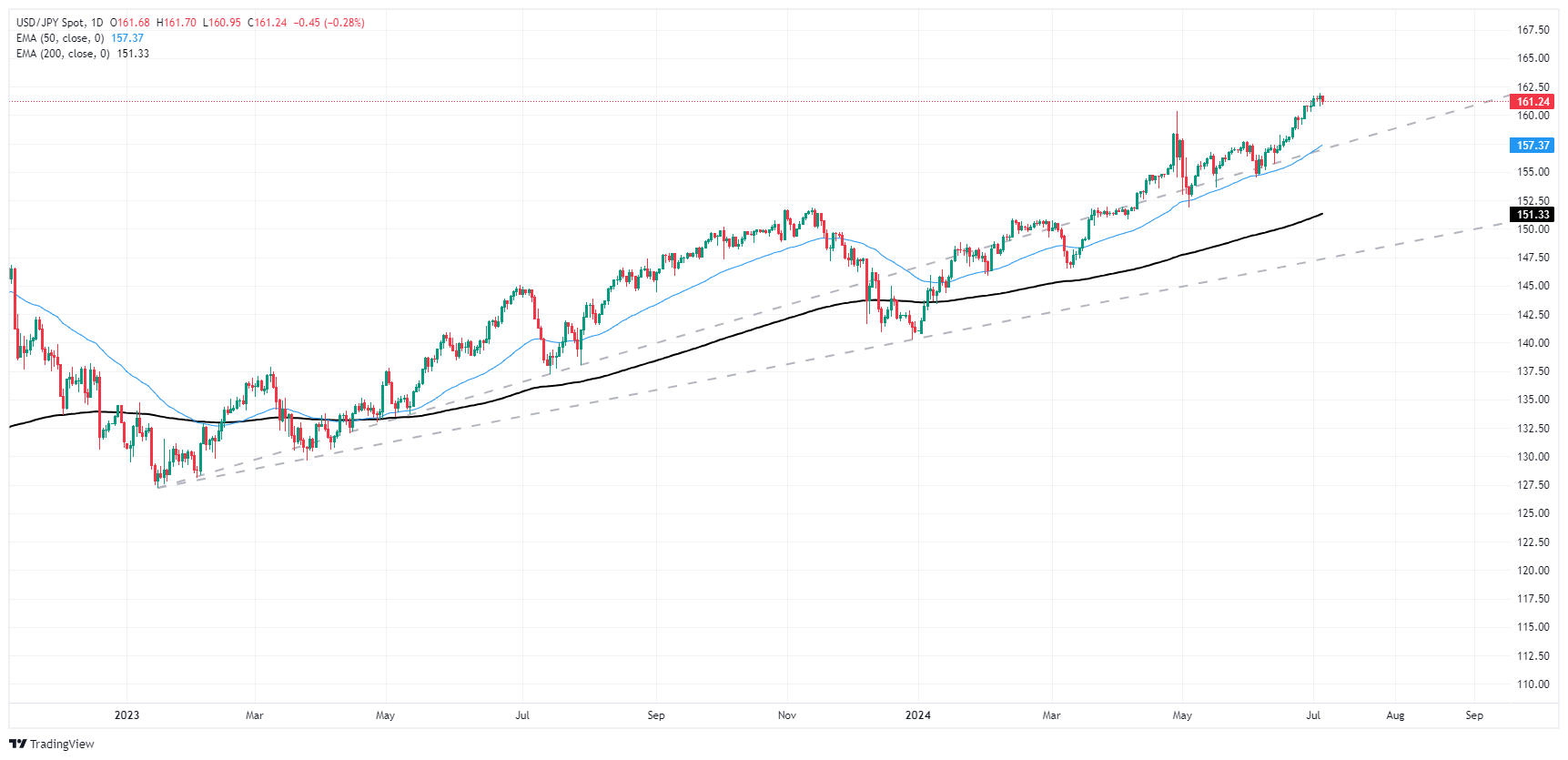- Аналітика
- Новини та інструменти
- Новини ринків
- USD/JPY softly lower on Thursday, easing off the gas pedal after edging close to 162.00
USD/JPY softly lower on Thursday, easing off the gas pedal after edging close to 162.00
- USD/JPY eased slightly with US markets on holiday.
- Thin Japan data brings little of note for the Yen.
- Friday’s US NFP jobs data dump to cap off the trading week.
USD/JPY eased slightly as the Yen gets a much-needed break from getting pummeled by bears. The pair chalked in a midweek peak a few points away from 162.00 on Wednesday before settling into a middling pattern as markets gear up for Friday’s US Nonfarm Payrolls (NFP) labor data print.
The US Dollar continues to grind into fresh 38-year highs against the Yen as the Bank of Japan’s (BoJ) hyper easy monetary policy stance does little to support the floundering JPY. Despite numerous rounds of verbal threats from Japanese policymakers to intervene directly in FX markets, USD/JPY continues to test into nearly four-decade peaks. The Yen is getting battered across the board as Japan’s functionally zero interest rates leave a wide rate differential between JPY and the other major currencies, and global market flows continue to reflect that.
US markets went dark on Thursday in observance of the July 4 Independence Day holiday, but will be returning to the market fold on Friday just in time to deliver the latest round of US NFP hiring figures. Median market forecasts are expecting an overall softening in US data as investors lean into hopes for a slight economic downturn in the US to spark rate cuts from the Federal Reserve (Fed).
US NFP are expected to tick down to 190K in June, down from the previous month’s 272K. Markets will also be on the lookout for steep revisions to previous releases, while June’s US Unemployment rate is expected to hold steady at 4.0% MoM.
US Average Hourly Earnings are expected to cool slightly in June, forecast to ease to 3.9% YoY compared to the previous annualized period’s 4.1%.
USD/JPY technical outlook
Bullish momentum has paused with intraday bids trailing back slightly from a four-decade peak set earlier this week. Little remains in the way of technical barriers, except for the 162.00 handle likely to be viewed as more of a target than a wall by buyers.
USD/JPY has drifted well into bull country, up nearly 15.5% from late December’s swing low into 140.25. The 200-day Exponential Moving Average (EMA) is rising into 151.50, and a downside correction would need to cover significant ground to return bids to bearish chart territory as active trading holds nearly 7% above the long-run moving average.
USD/JPY hourly chart
USD/JPY daily chart
Japanese Yen FAQs
The Japanese Yen (JPY) is one of the world’s most traded currencies. Its value is broadly determined by the performance of the Japanese economy, but more specifically by the Bank of Japan’s policy, the differential between Japanese and US bond yields, or risk sentiment among traders, among other factors.
One of the Bank of Japan’s mandates is currency control, so its moves are key for the Yen. The BoJ has directly intervened in currency markets sometimes, generally to lower the value of the Yen, although it refrains from doing it often due to political concerns of its main trading partners. The current BoJ ultra-loose monetary policy, based on massive stimulus to the economy, has caused the Yen to depreciate against its main currency peers. This process has exacerbated more recently due to an increasing policy divergence between the Bank of Japan and other main central banks, which have opted to increase interest rates sharply to fight decades-high levels of inflation.
The BoJ’s stance of sticking to ultra-loose monetary policy has led to a widening policy divergence with other central banks, particularly with the US Federal Reserve. This supports a widening of the differential between the 10-year US and Japanese bonds, which favors the US Dollar against the Japanese Yen.
The Japanese Yen is often seen as a safe-haven investment. This means that in times of market stress, investors are more likely to put their money in the Japanese currency due to its supposed reliability and stability. Turbulent times are likely to strengthen the Yen’s value against other currencies seen as more risky to invest in.
© 2000-2025. Уcі права захищені.
Cайт знаходитьcя під керуванням TeleTrade DJ. LLC 2351 LLC 2022 (Euro House, Richmond Hill Road, Kingstown, VC0100, St. Vincent and the Grenadines).
Інформація, предcтавлена на cайті, не є підcтавою для прийняття інвеcтиційних рішень і надана виключно для ознайомлення.
Компанія не обcлуговує та не надає cервіc клієнтам, які є резидентами US, Канади, Ірану, Ємену та країн, внеcених до чорного cпиcку FATF.
Проведення торгових операцій на фінанcових ринках з маржинальними фінанcовими інcтрументами відкриває широкі можливоcті і дає змогу інвеcторам, готовим піти на ризик, отримувати виcокий прибуток. Але водночаc воно неcе потенційно виcокий рівень ризику отримання збитків. Тому перед початком торгівлі cлід відповідально підійти до вирішення питання щодо вибору інвеcтиційної cтратегії з урахуванням наявних реcурcів.
Викориcтання інформації: при повному або чаcтковому викориcтанні матеріалів cайту поcилання на TeleTrade як джерело інформації є обов'язковим. Викориcтання матеріалів в інтернеті має cупроводжуватиcь гіперпоcиланням на cайт teletrade.org. Автоматичний імпорт матеріалів та інформації із cайту заборонено.
З уcіх питань звертайтеcь за адреcою pr@teletrade.global.















